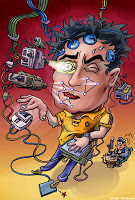 |
| image credit: SceneTap |
Nicholas West
Activist Post
Do you want to tap into your local scene? Are you a tourist looking for some action-packed nightlife? Or do you want to find a quiet out-of-the way place for a romantic evening?
A new facial “detection” app has hit the bar market in San Francisco, and its intentions are coming under scrutiny by potential patrons.
SceneTap is one of a plethora of private companies who are using the military tech of biometrics to database your face in a quest to offer convenience and enhanced social networking, paving the way toward making “anonymous” biometric information part of one’s entertainment repertoire with trendy tech applications.
Facial recognition technology, and the databases that catalog and store the results, is advancing at a pace that is difficult to contain. In 2006, the performance of face recognition algorithms were evaluated in the Face Recognition Grand Challenge (FRGC). High-resolution face images, 3-D face scans, and iris images were used in the tests. The results indicated that the new algorithms are 10 times more accurate than the face recognition algorithms of 2002 and 100 times more accurate than those of 1995. Some of the algorithms were able to outperform human participants in recognizing faces and could uniquely identify identical twins. (Source)
And that was 2006. One of the latest military-grade systems can now scan 36 million faces per second, or every face in the U.S. within 10 seconds. It is a technology that has trickled down from use in war zones like Afghanistan to catalog potential terrorists, to U.S. border control applications for combating illegal immigration, to FBI crime detection, to post-riot analysis, and right on down to establishing personal ID for a wide range of private companies.
In a detailed article discussing the commercial applications of this military biometric technology and the pace of development, Madison Ruppert commented:
The widespread acceptance of this trend, and the almost nonexistent resistance to it, is somewhat disturbing to me.
Maybe the American people, and the people of the world for that matter, will not start to care until facial recognition cameras are on every corner, in every home, business, and other public places. (Source)
That article was written at the end of March of this year, and we are already in a situation where facial recognition is beginning to permeate our daily lives as a form of government surveillance. The general acceptance seems to have led the entertainment sector to embrace it as well, leading to a full-spectrum analysis of who we are, where we have been, and where we are going.
- Google rolled out facial recognition as a ‘Find My Face’ tool for Google+ after conceding that it was the only technology that they had ever initially held back for fear it was “too dangerous.” Six months after that assessment, they released it to very little opposition.
- A facial recognition system has been employed at the London Science Museum where visitors can participate in an ongoing experiment about how people remember faces.
- Apple iPhoto, photo organizer distributed with iLife suite of applications includes a system by which people can tag recognized people on photos. Then they can be searched using Spotlight.
- Sony’s Picture Motion Browser (PMB) analyzes photo, associates photos with identical faces so that they can be tagged accordingly, and differentiates between photos with one person, many persons and nobody.
- Windows Live Photo Gallery also included face recognition in last version.
Spaceship Earth in Epcot uses a facial recognition system to place the riders’ faces on animated characters.
Thus far, these have been fun virtual applications. The SceneTap program, however, is every bit as real world as what the military employs to collect information and use it for applied tracking and reporting capabilities. This has people in San Francisco concerned, as the technology is set to be rolled out this weekend in 25 bars. Furthermore, SF nightlife visitors already have been subjected to being live-streamed from their local haunts against their knowledge.
SceneTap CEO, Cole Harper, appeared puzzled in his recent e-mail interview with SFWeekly about any concerns patrons might have; he points out that his company has successfully implemented the tech in other markets since their launch.
We launched in July 2011 at 50 venues in Chicago and have since expanded to Austin (Texas), Bloomington (Ind.), Gainesville (Fla.), Athens (GA) and Madison (Wis.)
He went on to reiterate much of what appears in the company’s FAQ section of their website, which I’ve reproduced in full below to offer a balanced assessment:
How does SceneTap’s technology work?
SceneTap uses anonymous facial detection software placed inside a venue. Based on facial characteristics of patrons, SceneTap technology approximates age and gender with a high degree of accuracy.
SceneTap also counts the number of people entering and leaving the venue at any given time to report crowd size.
This seems ‘Big Brother’-ish. Is my privacy at risk?
Not at all. In fact, SceneTap has no idea who you are and does not collect personal information. You give up your personal information when a doorman scans your ID or you check in via foursquare, but not when you enter a SceneTap venue. It’s less intrusive than paying a bill with a credit card.
Though the software is video-based, SceneTap does not stream or record images, and no one – including the operator of the venue – has access to the video.
Where is all this information processed?
The software can only identify facial features and accurately estimate each person’s gender and age. This information is processed by the software connected to the sensors in each venue.
Are you selling my personal information in an attempt to achieve world domination?
No. Facial detection technology cannot identify individuals.
What is the difference between facial detection and facial recognition?
SceneTap uses a technology known as ‘facial detection’ in order to deliver real-time information on the scene of its partner venues. Commonly mistaken for ‘facial recognition’, facial detection merely detects the presence of a face and estimates the gender and age of the face based on how it appears. Facial recognition, which attempts to determine a person’s actual identity, is a technology that SceneTap neither uses nor has any plans to use. Our goal is to give you an entertaining and informative tool that helps you answer a common question, “What’s it like at my favorite venues right now?”
Whether or not SceneTap’s intentions are wholly benign, we are continuously presented with abuses of our trust when demanding a right to privacy. And we have been lied to by agencies like the TSA who have made similar assertions to SceneTap’s CEO that they don’t store the information and it is completely anonymous.
Wittingly or unwittingly, this appears to be just one more step along the path of acclimating the public that not only is it OK to be tracked, traced, and databased if you have nothing to hide, but that it can also be fun to see and be seen at all times.
Here’s a list of the bars that will begin using technology starting Friday.
What do you think of this technology? Cool service, or another piece of the Big Brother Surveillance Grid? Please leave your comments below.
Main sources for this article:
http://blogs.sfweekly.com/thesnitch/2012/05/scenetap_ceo_defends_facial_de.php
http://blogs.sfweekly.com/thesnitch/2012/05/scenetap_facial_recognition.php
Additional Source (final three bullet points):
http://en.wikipedia.org/wiki/Facial_recognition_system
See more articles by Nicholas West HERE.
You can support this information by voting on Reddit HERE.
linkwithin_text=’Related Articles:’




Be the first to comment on "Facial Recognition Goes Trendy with SceneTap’s Biometric Barhopping App"